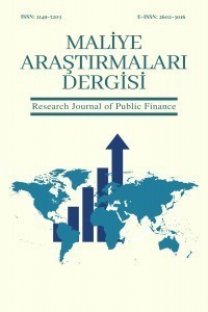Modelling Capital Controls under the Purchasing Power Parity Assumption
Anahtar Kelimeler:
Capital Controls, Differential Equation Systems, Purchasing Power Parity
Modelling Capital Controls under the Purchasing Power Parity Assumption
This study explores the effects of capital controls in the long run. At this juncture the assumption of purchasing power parity has been employed. The model of the study is based on differential equation systems analysis. The present study results show that capital constraints reduce the volatility of the exchange rate in the long run
___
Barro, R. J. and X. Sala-I- Martın (2004), ‘Economic Growth’, The Mit Press, İkinci Baskı, Cambridge, MA.Brock, W. A. and A. G. Malliaris (1996), ‘Differential Equations, Stability and Chaos in Dynamic Economics’, Elsevier Science B. V., Amsterdam, Hollanda.
Cardenas, M. and F. Barrera (1997), ‘On the Effectiveness of Capital Controls:The Experience of Colombia During the 1990s,’ Journal of Development Economics, Vol. 54, No. 1, s. 27–57.
Cardoso, E. and I. Goldfajn (1998) ‘Capital Flows to Brazil: The Endogeneity of Capital Controls’, IMF Staff Papers, International Monetary Fund, Vol. 45, No. 1, s. 161–202.
De Gregorio, J., S. Edwards and R. O. Valdes (2000), ‘Controls on Capital Inflows: Do They Work?,’ Journal of Development Economics, Vol. 63, No. 1, s. 59–83.
Dornbusch, R. (1976), ‘Expectations and Exchange Rate Dynamics’, Journal of Political Economy, Vol. 84/6, s. 1161-1176.
Dornbusch, R. (1985), ‘Purchasing Power Parity’, Natioal Bureau of Economic Research, Working Paper No: 1591, Cambridge, Mart, s.1- 37.
Eichengreen, B. (2003), ‘Capital Flows and Crises’, The MIT Press., Cambridge, MA.
Engel, C. (2012), ‘Capital Controls: What Have We Learned?’, BIS Papers, No 68, s. 22-26.
Frenkel, J. and K. Froot (1988) ‘Chartists, Fundamentalists and the Demand for Dollars’, Greek Economic Review, Vol. 10, s. 49 - 102.
Frenkel, M., C. Nickel, G. Schmidt and G. Stadtmann (2001) ‘The Effects Of Capital Controls on Exchange Rate Volatility and Output’, IMF Working Paper (International Monetary Fund, Monetary and Exchange Affairs Department), Vol. WP/01/187, s. 1–29.
Goh, S. K. (2005), ‘New Empirical Evidence on the Effects of Capital Controls on Composition of Capital Flows in Malaysia’, Applied Economics, Vol. 37 (July), s. 1491–503.
Goh, S. K. (2009), ‘Managing the Impossible Trinity: The Case of Malaysia’, Munich Personal RePEc Archive, Paper No: 18094.
Habermeier, K., A. Kokenzne and C. Baba. (2011), ‘The Effectiveness of Capital Controls and Prudential Policies in Managing Large Inflows’, Internatıonal Monetary Fund Monetary and Capital Markets Department, Authorized for distribution by José Viñals August 5.
Hayden, G. (2011), ‘You Kant Make It Up: Strange Ideas From History’s Great Philosophers’ Oneworld Publications, Oxford, İngiltere, s. 5-6.
Jittrapanun, T. and S. Prasartset (2009), ‘Hot Money and Capital Controls in Thailand’, TWN Global Economy Series, Penang, Malaysia: Third World Network.
Magud, N. E., C. M. Reınhart (2006), ‘Capital Controls: An Evaluation’, National Bureau of Economic Research, Working Paper Number: 11973.
Magud, N. E., C. M. Reinhart, and K. S. Rogoff (2011), ‘Capital Controls: Myth and Reality – A Portfolio Balance Approach’, National Bureau of Economic Research, Working Paper N: 16805.
Shone, R. (2002), ‘Economic Dynamics, Phase Diagrams and Their Economic Application’, Cambridge University Press, Second Edition, New York.
Stachurski, J. (2009), ‘Economic Dynamics Theory and Computation’, The Mit Press, Cambridge, Massachusetts, London, İngiltere.
Taylor, A. M. and M. P. Taylor (2004), ‘The Purchasing Power Parity Debate’, Journal of Economic Perspectives, Vol 18, Number 4, Fall, s. 135-158.
- ISSN: 2149-5203
- Yayın Aralığı: Yılda 2 Sayı
- Başlangıç: 2015
- Yayıncı: PESA
